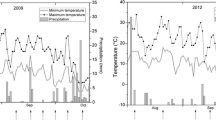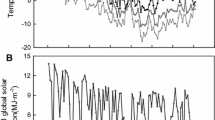Abstract
To provide a theoretical basis for revealing the mechanism of winter leaf reddening in evergreen species, the relationships between winter leaf reddening, reactive oxygen species (ROS) and the antioxidant system of Buxus microphylla ‘Wintergreen’ were studied. The pigment changes, ROS production, lipid peroxidation and antioxidants activities of sun leaves during the reddening and regreening processes were investigated, using green shade leaves as controls. The carotenoids in the sun leaves increased linearly with reddening but decreased with the regreening. There was no significant difference in either the superoxide anions (O −·2 ) or malondialdehyde (MDA) changes between the sun and shade leaves, and their O −·2 contents were positively correlated with MDA. In contrast to the shade leaves, the sun leaves showed a trend in which the hydrogen peroxide (H2O2) changes were closely related to the reddening process and positively correlated with carotenoids content but not with the MDA content. A similar trend was observed for catalase (CAT) and ascorbate peroxidase (APX) activity between the sun and shade leaves, but superoxide dismutase (SOD) and peroxidase (POD) activity and the ascorbate (AsA) content differed between these two ecotypes. Furthermore, the sun leaves had higher CAT activity and AsA content than the corresponding shade leaves. These results suggested that H2O2 might play an important role in the winter reddening of sun leaves by promoting the accumulation of carotenoids. In addition, SOD, POD and AsA probably play a photoprotective role in winter-red sun leaves, while the changes in O −·2 , CAT and APX were independent of winter leaf reddening and were more likely responses to stress caused by low temperatures.





Similar content being viewed by others
References
Arora R, Rowland LJ (2011) Physiological research on winter-hardiness: deacclimation resistance, reacclimation ability, photoprotection strategies, and a cold acclimation protocol design. HortScience 46:1070–1078
Bouvier F, Backhaus RA, Camara B (1998) Induction and control of chromoplast-specific carotenoid genes by oxidative stress. J Biol Chem 273:30651–30659
Breusegem FV, Vranová E, Dat JF, Inzé D (2001) The role of active oxygen species in plant signal transduction. Plant Sci 161:405–414
Cansev A, Gulen H, Eris A (2011) The activities of catalase and ascorbate peroxidase in olive (Olea europaea L. cv. Gemlik) under low temperature stress. Hortic Environ Biotechnol 52:113–120
Carpenter KL, Keidel TS, Pihl MC, Hughes NM (2014) Support for a photoprotective function of winter leaf reddening in nitrogen-deficient individuals of Lonicera japonica. Molecules 19:17810–17828
Casano LM, Gómez LD, Lascano HR, González CA, Trippi VS (1997) Inactivation and degradation of CuZn-SOD by active oxygen species in wheat chloroplasts exposed to photooxidative stress. Plant Cell Physiol 38:433–440
Chang HL, Kang CY, Lee TM (2013) Hydrogen peroxide production protects Chlamydomonas reinhardtii against light-induced cell death by preventing singlet oxygen accumulation through enhanced carotenoid synthesis. J Plant Physiol 170:976–986
Dhindsa RA, Plumb-Dhindsa P, Thorpe TA (1981) Leaf senescence: correlated with increased permeability and lipid peroxidation, and decreased levels of superoxide dismutase and catalase. J Exp Bot 126:93–101
Distelbarth H, Nägele T, Heyer AG (2013) Responses of antioxidant enzymes to cold and high light are not correlated to freezing tolerance in natural accessions of Arabidopsis thaliana. Plant Biol 15:982–990
Domonkos I, Kis M, Gombos Z, Ughy B (2013) Carotenoids, versatile components of oxygenic photosynthesis. Prog Lipid Res 52:539–561
Eskling M, Arvidsson PO, Åkerlund HE (1997) The xanthophyll cycle, its regulation and components. Physiol Plantarum 100:806–816
Fischer BB, Hideg É, Krieger-Liszkay A (2013) Production, detection, and signaling of singlet oxygen in photosynthetic organisms. Antioxid Redox Sign 18:2145–2162
Garg N, Manchanda G (2009) ROS generation in plants: boon or bane? Plant Biosyst 143:81–96
Gill SS, Tuteja N (2010) Reactive oxygen species and antioxidant machinery in abiotic stress tolerance in crop plants. Plant Physiol Biochem 48:909–930
Han Q, Katahata S, Kakubari Y, Mukai Y (2004) Seasonal changes in the xanthophyll cycle and antioxidants in sun-exposed and shaded parts of the crown of Cryptomeria japonica in relation to rhodoxanthin accumulation during cold acclimation. Tree Physiol 24:609–616
Hormaetxe K, Hernández A, Becerril JM, García-plazaola (2004) Role of red carotenoids in photoprotection during winter acclimation in Buxus sempervirens leaves. Plant Biol 6:325–332
Hormaetxe K, Becerril JM, Fleck I, Pintó M, García-Plazaola JI (2005) Functional role of red (retro)-carotenoids as passive light filters in the leaves of Buxus sempervirens L.: increased protection of photosynthetic tissues? J Exp Bot 56:2629–2636
Hughes NM (2011) Winter leaf reddening in ‘evergreen’ species. New Phytol 190:573–581
Hughes NM, Smith WK (2007) Seasonal photosynthesis and anthocyanin production in ten broadleaf evergreen species. Funct Plant Biol 34:1072–1079
Hughes NM, Carpenter KL, Keidel TS, Miller CN, Waters MN, Smith WK (2014) Photosynthetic costs and benefits of abaxial versus adaxial anthocyanins in Colocasia esculenta ‘Mojito’. Planta 240:971–981
Ida K, Masamoto K, Maoka T, Fujiwara Y, Takeda S, Hasegawa E (1995) The leaves of the common box, Buxus sempervirens (Buxaceae), become red as the level of a red carotenoid, anhydroeschscholtzxanthin, increases. J Plant Res 108:369–376
Iigusa H, Yoshida Y, Hasunuma K (2005) Oxygen and hydrogen peroxide enhance light-induced carotenoid synthesis in Neurospora crassa. FEBS Lett 579:4012–4016
Jiang XR, Peng JG, Guo L, Gao RF, Liu Y (2015) Relationship between winter leaf reddening and carotenoids, reactive oxygen species in Buxus microphylla L. J Beijing For Univ 37:93–99 (in Chinese)
Kaku S, Iwaya-Inoue M, Toki K (1992) Anthocyanin influence on water proton NMR relaxation times and water contents in leaves of evergreen woody plants during the winter. Plant Cell Physiol 33:131–137
Kampfenkel K, Montagu MV, Inzé D (1995) Extraction and determination of ascorbate and dehydroascorbate from plant tissue. Anal Biochem 225:165–167
Koiwa H, Ikeda T, Yoshida Y (1986) Reversal of chromoplasts to chloroplasts in Buxus leaves. Bot Mag Tokyo 99:233–240
Li HS, Sun Q, Zhao SJ, Zhang WH (2000) Assay of malondialdehyde in plants. Experiment principle and technology of plant physiology and biochemistry. Higher Education Press, Beijing, pp 260–261 (in Chinese)
Lichtenthaler HK, Wellburn AR (1983) Determinations of total carotenoids and chlorophylls a and b of leaf extracts in different solvents. Biochem Soc Trans 11:591–592
Mittler R (2002) Oxidative stress, antioxidants and stress tolerance. Trends Plant Sci 7:405–410
Nakano Y, Asada K (1981) Hydrogen peroxide is scavenged by ascorbate specific peroxidases in spinach chloroplasts. Plant Cell Physiol 22:867–880
Pandhair V, Sekhon BS (2006) Reactive oxygen species and antioxidants in plants: an overview. J Plant Biochem Biot 15:71–78
Passardi F, Cosio C, Penel C, Dunand C (2005) Peroxidases have more functions than a Swiss army knife. Plant Cell Rep 24:255–265
Peng JG, Liu Y, Guo L, Gao RF (2011) Color change and chlorophyll fluorescence kinetics characteristics of Buxus microphylla leaves during the period of overwintering and regreening. J Beijing For Univ 33:27–34 (in Chinese)
Prochazkova D, Sairam RK, Srivastava GC, Singh DV (2001) Oxidative stress and antioxidant activity as the basis of senescence in maize leaves. Plant Sci 161:765–771
Ramel F, Birtic S, Cuiné S, Triantaphylidès S, Ravanat JL, Havaux M (2012) Chemical quenching of singlet oxygen by carotenoids in plants. Plant Physiol 158:1267–1278
Ruelland E, Vaultier MN, Zachowski A, Hurry V (2009) Cold signaling and cold acclimation in plants. Adv Bot Res 49:35–150
Sergiev I, Alexieva V, Karanov E (1997) Effect of spermine, atrazine and combination between them on some endogenous protective systems and stress markers in plants. Compt Rend Acad Bulg Sci 51:121–124
Shabnam N, Pardha-Saradhi P (2016) Floating and submerged leaves of Potamogeton nodosus exhibit distinct variation in the antioxidant system as an ecophysiological adaptive strategy. Funct Plant Biol 43:346–355
Sofo A, Scopa A, Nuzzaci M, Vitti A (2015) Ascorbate peroxidase and catalase activities and their genetic regulation in plants subjected to drought and salinity stresses. Int J Mol Sci 16:13561–13578
Triantaphylidès C, Havaux M (2009) Singlet oxygen in plants: production, detoxification and signaling. Trends Plant Sci 14:219–228
Velissarios-Phaedon K, Yiannis M (2006) Mesophyll versus epidermal anthocyanins as potential in vivo antioxidants: evidence linking the putative antioxidant role to the proximity of oxy-radical source. J Exp Bot 57:2203–2210
Verhoeven AS, Swanberg A, Thao M, Whiteman J (2005) Seasonal changes in leaf antioxidant systems and xanthophyll cycle characteristics in Taxus x media growing in sun and shade environments. Physiol Plant 123:428–434
Wang AG, Luo GH (1990) Quantitative relation between the reaction of hydroxylamine and superoxide anion radicals in plants. Plant Physiol Commun 6:55–57 (in Chinese)
Wang X, Peng Y, Singer JW, Fessehaie A, Krebs SL, Arora R (2009) Seasonal changes in photosynthesis, antioxidant systems and ELIP expression in a thermonastic and non-thermonastic Rhododendron species: a comparison of photoprotective strategies in overwintering plants. Plant Sci 177:607–617
Wen L, Chen T (2014) Responses of pigmentation and δ13C in Qilian juniper to cold and drought stresses under natural conditions in the Qilian Mountains, China. Acta Physiol Plant 36:2211–2218
Wise RR (1995) Chilling-enhanced photooxidation: the production, action and study of reactive oxygen species produced during chilling in the light. Photosynth Res 45:79–97
Yang Y, Han C, Liu Q, Lin B, Wang J (2008) Effect of drought and low light on growth and enzymatic antioxidant system of Picea asperata seedlings. Acta Physiol Plant 30:433–440
Zhang XZ (1986) Determination of chlorophyll content in plants by acetone-ethanol mixture method. Liaoning Agric Sci 3:26–28 (in Chinese)
Zipor G, Oren-Shamir M (2013) Do vacuolar peroxidases act as plant caretakers? Plant Sci 199–200:41–47
Acknowledgments
This work was supported by the Beijing Municipal Science and Technology Commission (Z08050602970801). The authors are grateful to Beijing Botanical Garden Seedling Center for conservation of the testing plants.
Author information
Authors and Affiliations
Corresponding author
Ethics declarations
Conflict of interest
The authors declare that they have no conflict of interest.
Additional information
Communicated by J Gao.
Xue-ru Jiang and Jin-gen Peng contributed equally to this work.
Rights and permissions
About this article
Cite this article
Jiang, Xr., Peng, Jg., Jia, Mx. et al. Relationship between leaf reddening, ROS and antioxidants in Buxus microphylla during overwintering. Acta Physiol Plant 38, 199 (2016). https://doi.org/10.1007/s11738-016-2206-7
Received:
Revised:
Accepted:
Published:
DOI: https://doi.org/10.1007/s11738-016-2206-7




